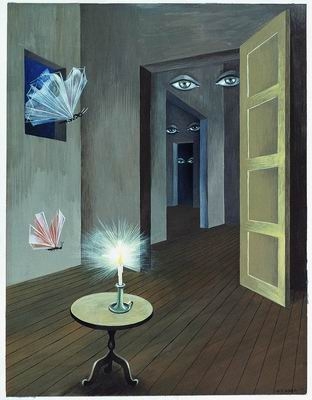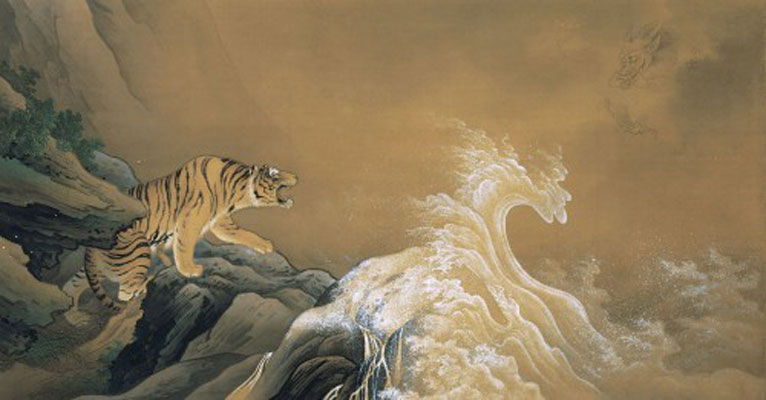After the destruction of World War 1, it was harder for artists to go back to more traditional and lighthearted art styles. Many of the styles that emerged were abstract and were more experimental than before. Some styles were even direct stances against what they believed to be the root cause of the war, tradition.
Dada
The artists of the Dada movement took on a nihilistic view after the war rejecting tradition. Marcel Duchamp is said to have rejected art that was made for the eyes, and not the mind. They wanted to embrace the absurd, illogical, and many of the artists chose not to use the human form unless it was distorted or made to seem manufactured.
Dada Puppen (1916) by Hannah Höch in Berlin, Germany. Courtesy of Kunstdunst
Most of Hannah Höch's work is dadaist photomontages, but this piece is a pair of dolls that are said to be inspired by Hugo Ball's performance at Cabaret Voltaire. It is said that the shapes of the doll's clothing resemble the geometric costume Hugo Ball wore during the performance; unfortunately, I could not find a photo to compare the two. Whether Hannah was truly inspired by Ball or not, the dolls give off an industrial feel. To me, they almost look as if they're wearing spacesuits.
I like the playfulness of the dolls, that you recognize them as the human form, but there is something very off about them. The colors of the dolls aren't very vibrant and that they're disjointed, but I think it adds to the mechanical feel. What I like most of all are the shapes within the dolls, how the taller one has a triangular skirt and the circular forms on the smaller doll's shoulders and knees. Many in the dada movement believed that technology was turning mankind into machines themselves, and it is speculated that this is what Hannah was trying to portray. Another speculation as to why Höch, and other dada artists, portrayed the human form as mechanical or mutilated is the many soldiers who returned home as amputees and with prosthetics.
Surrealism
Surrealism was created from dadaism and influenced by Sigmund Freud and dream worlds. Some artists focused on creating whatever comes to their mind with no planning, while others focused on dreamscapes and the unconscious mind. Artists turned to surrealism after they thought dadaism became too organized and lost its original intent.
Insomnia (1947) by Remedios Varo in Mexico. Courtesy of MutualArt
This painting was actually commissioned by the Bayer company to advertise sleeping pills, it represents what insomnia feels like. What I really like about this piece is the hard lines throughout the painting, and the weirdness of the scene. To me it really does seem like a sleep disorder come to life with the eyes watching from every corner, and there is a sense of anxiety and sense of being trapped in a dark space. The perspective that Varo uses, makes it so the viewer can see through multiple doorways, so the eyes to look both far away and very close adding to the feeling of unease.
Surrealism continues the uncertain and darker imagery that was born from post World War 1 sentiment that dadaism had, but it starts to focus more on projecting those feelings, along with influences from Freud, into dream like worlds. Personally, I prefer surrealism over dadaism but it is mostly due to aesthetic tastes. I like how experimental and creative the dada movement was, but something about surrealism apeals to me more.
De Stijl
De Stijl, meaning the style, was a reaction to the excess of art deco, and so this style focuses on form and function rather than any frills. It was also a reaction to the horrors of war, the movement wanted to recreate society and uphold an idea of a utopia. Many artists embraced geometric shapes and lines and creating harmony in their designs.

Rietveld Schröder House (1924) by Gerrit Rietveld in Netherlands. Courtesy of The Collector
The architecture of the De Stijl movement is pretty iconic, you can see the geometric shapes that inspired the design clearly and there are pops of primary colors that are a staple in this style. Inside the house there are sliding walls to make spaces bigger or smaller depending on the need. I like the architecture of this art style, but the other forms of art work are a little too simple for my taste. I appreciate the emphasis on function that the artists had and some of the creative solutions Rietveld had for the house. I reccomend that people look at other views and more inside photos of the house, it is pretty cool inside.

Inside view of Rietveld Schröder House
Final Thought
All three of these art movements are the aftermath of World War 1 and the reaction to the horrors of it. Some styles are a commentary on what they believe is the cause, and others are ways to try and transform the world after the chaos. All three are very different than the styles that came before them, the focus of art was changing during this time. I think all three are very interesting and learning the context of the pieces is as interesting as the pieces, some art styles I prefered over others but overall they're all visually interesting.
Sources
Dadaism - Art and Anti Art, Arty Factory , www.artyfactory.com/art_appreciation/art_movements/dadaism.htm.
Seiferle, Rebecca. “Remedios Varo Artworks & Famous Paintings.” The Art Story, 20 Sept. 2017, www.theartstory.org/artist/varo-remedios/artworks/.
Souter, Anna. “Hannah Höch Artworks & Famous Photomontages.” The Art Story, 21 Jan. 2016, www.theartstory.org/artist/hoch-hannah/artworks/.
“Surrealism Movement Overview.” The Art Story, 21 Dec. 2011, www.theartstory.org/movement/surrealism/.
Trachtman, Paul. “A Brief History of Dada.” Smithsonian.com, Smithsonian Institution, 1 May 2006, www.smithsonianmag.com/arts-culture/dada-115169154/.
“Unesco World Heritage in Utrecht.” Rietveld Schröder House, 9 June 2021, www.rietveldschroderhuis.nl/en/rietveld-schroder-house.
Wolf, Justin. “De Stijl Movement Overview.” The Art Story, 22 Nov. 2011, www.theartstory.org/movement/de-stijl/.



Thank you for all the info. I really enjoy the insomnia painting. It surprised me that it was to express how insomnia felt because my first reaction was that it was mysterious. Looking back at it I can feel the unsettling feeling that this piece expresses. I like how the shades of light on the walls reflect the light emitting from the lamp. It is also visually pleasing to see the brush strokes in the wall, it looks nice with the bold shadow in the middle of this piece. I also enjoyed the De Stijl movement pieces. I love functionality, and this movement is still celebrated and used today. I like how in the Rietveld Schoder House, the use of the stairs and the natural light made the space look bigger. The use of the bold blue and red are the perfect pops of color
ReplyDeleteGreat blog post! I find surrealism very interesting and I really liked the piece you chose. When I looked at it my first impression was that it almost felt like a scene from a nightmare, so it makes sense that it's supposed to illustrate the feeling of insomnia and just the feeling of not being able to close your eyes.
ReplyDelete